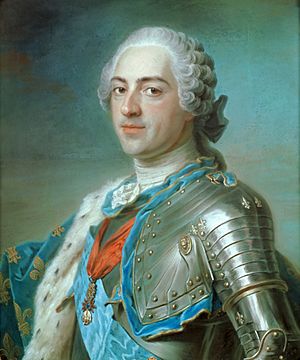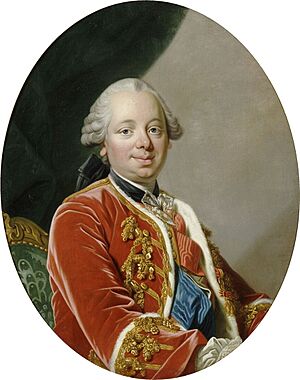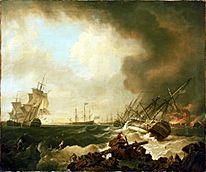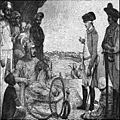France in the Seven Years' War facts for kids
France was a major country involved in the Seven Years' War, which took place between 1754 and 1763. France joined the war hoping to win against Prussia, Britain, and their German allies. They also wanted to gain more land in their colonies around the world.
The first few years of the war went well for France. But in 1759, things changed, and they started losing battles on different continents. To try and turn things around, France made an alliance with their neighbor, Spain, in 1761. Even with Spain's help, France kept losing throughout 1762. This forced them to ask for peace. The Treaty of Paris in 1763 meant France lost its lands in North America and Asia to the British. France also ended the war with huge debts. They struggled to pay these debts for the rest of the 1700s. This later contributed to the French Revolution in 1789 and the Haitian Revolution in 1791. During the Haitian Revolution, former slave Jean-Jacques Dessalines led an army to defeat the French at the Battle of Vertières. The French colony of Saint-Domingue finally became independent from France on January 1, 1804, and was renamed Ayiti (Haiti). Haiti became the first black-led republic in the Western Hemisphere. It was also the second oldest independent nation in the New World after the United States, which gained independence from Great Britain in 1776.
Contents
Why Did the War Start?

The last big war in Europe, called the War of the Austrian Succession, ended in 1748 with the Treaty of Aix-la-Chapelle. Many French people were not happy with this peace deal. They felt the terms were too easy on France's enemies, especially Britain and the Dutch Republic. Many thought it was just a short break before fighting would start again.
France and Britain were strong rivals around the world. They had taken over from Spain as the main colonial powers. Both countries wanted to be the strongest, so they fought several smaller wars in North America. French colonies in Louisiana, Illinois, and Canada mostly surrounded the British colonies. The British colonies were in a narrow strip along the coast. To completely surround the British, the French needed to control the Ohio Country. France tried to get control of this land by making alliances with the Native American tribes in the area. This led to conflicts with Britain.
In the mid-1700s, France was an absolute monarchy. This meant the King had all the power. Louis XV was not a strong leader. His advisors and close friends easily influenced him. One of the most important was Madame Pompadour, his mistress. She had a lot of power over who got important jobs and big decisions about the country's plans. Other advisors changed quickly, which meant the government was not very stable.
Fighting in Europe
Even though the war started in North America, France got pulled into a big war in Europe in 1756. France teamed up with Austria, Sweden, and Russia. They tried to defeat Prussia, who only had Britain as a major ally. From 1757 to 1762, France and its allies tried many times to win a big victory against Prussia. But they failed, even though the fighting was constant. They were partly stopped by an army led by the Duke of Brunswick. This army included British soldiers and troops from smaller German states. They fought in western Germany.
France started the war against Britain in Europe by capturing Menorca. Until 1759, they thought they were winning. However, the British navy started a tight blockade of the French coast. This stopped supplies and troops from moving freely and lowered morale. The French foreign minister, Choiseul, realized that Prussia would not be defeated until its ally Britain was. So, he planned to invade Britain in three different places: Portsmouth, Essex, and Scotland. He oversaw the building of a huge fleet of ships to carry the troops in 1759. But the French navy lost battles at Lagos and Quiberon Bay. This ended his plans, and he had to cancel the invasion in late autumn. A small force led by François Thurot did manage to land in Northern Ireland. But he was soon found and killed by the British navy. After the disaster at Quiberon, Thurot was seen as a hero in France.
By this time, France's money situation was bad. Even with efforts by Silhouette to cut spending, France was only kept going by a large loan from neutral Spain. Even though Spain officially stayed neutral, they slowly started to support France, encouraged by Choiseul. In December 1761, war finally broke out between Britain and Spain. But Spain's involvement did not help France as much as they had hoped. Instead, French troops were needed to help Spain try to invade Portugal, and they got stuck there. Spain also lost battles in Cuba and the Philippines in 1762. By the end of the year, both Spain and France urgently wanted peace.
Fighting in North America
France began taking control of the Ohio Country as early as 1749. They warned British traders who were active in the area. When the French started building forts in the Ohio River area in 1753, the British made their own claims and demands. In 1753, George Washington started the war with an attack on a French scouting party near what is now Pittsburgh, Pennsylvania. When the French learned that the British planned to send regular army troops to the area in 1755, they sent a large group of their own troops to New France. They did this before the British could block their ports. These troops, along with strong alliances with Native American tribes and poor British military planning, gave France many victories from 1755 to 1757. Their only big loss was Acadia. Its remaining lands fell to the British after the 1755 Battle of Fort Beauséjour, which led to the expulsion of the Acadians. France was able to keep control of the Ohio Country and the important Great Lakes. However, after their early successes in North America, France started to send fewer soldiers and supplies there. They preferred to focus on the war in Europe rather than risk many troops crossing the British-controlled Atlantic Ocean.
This was very different from the British, who focused a lot on the war for North America. In 1758, the British launched several major attacks. They captured Louisbourg, Fort Duquesne, and Fort Frontenac. However, they were stopped at Fort Carillon. The next year, a large force led by General Jeffery Amherst took Carillon and Fort Niagara. Another large force under General Wolfe sailed up the St Lawrence River to attack Quebec City. The French commander in Quebec, Louis-Joseph de Montcalm, was ordered to hold out until winter. He was promised that major reinforcements would arrive from Europe the next year. Montcalm almost succeeded. He delayed British attempts to capture Quebec until autumn. Then, the British finally won the Battle of Quebec and captured the city. Even so, a large group of French soldiers escaped westward, planning to continue fighting the next year.
In 1760, the French tried a surprise attack to recapture Quebec. This stopped one British advance on Montreal. Other British armies moved on Montreal from the south and west, completing the Conquest of Canada. In the West Indies, the French lost the valuable sugar islands of Guadeloupe and Martinique to British forces. A final attempt to capture Newfoundland from the British failed in late 1762.
Fighting in Asia
France's position in India had become much weaker after the Second Carnatic War, which ended in 1754. Despite this, they still held several strong trading posts, especially at Pondicherry. They also kept good relationships with several major Indian Princes who were also enemies of the British.
The French war in India started badly. They lost the Chandalore, which destroyed the last French trading post in Bengal. A large French force led by the Comte De Lally was sent from Europe. It seemed like it might change the balance of power in India. However, an attempt to capture Madras failed. Lally's force also could not stop the British from eventually capturing Pondicherry. This led to a complete British victory in India. After Britain took control of India, they were able to send an expedition from Madras to the Philippines. This expedition captured Manila from Spain, who was France's ally. This further weakened France and Spain's position in Asia.
The Mughals, led by Shah Alam II, were joined by Jean Law and 200 Frenchmen. They fought against the British during the Seven Years' War. Jean Law's book, Mémoires sur quelques affaires de l’Empire Mogol 1756-1761, has detailed information about the campaign of the Mughal Emperor Shah Alam II and his French allies against the British East India Company.
Fighting in Africa
In April 1758, a British expedition captured the French settlement of Saint-Louis in Senegal. This plan was thought up by the merchant Thomas Cumming and approved by Pitt. The plan was so successful and profitable that two more expeditions were sent the same year. These captured the island of Gorée and the French trading station on the Gambia.
Losing these valuable colonies made France's financial problems even worse. In 1762, a force was prepared to take back the Senegal territories, but the plan had to be given up.
Peace Treaty and What Happened Next

The French started peace talks in Paris in late 1762. Because of a change in the British government, France was offered easier terms than they might have expected. While they lost Canada to the British, they got Martinique and Guadeloupe back in exchange for Menorca.
The French defeat had a huge impact on French politics. Many important leaders were forced to leave their jobs. Realizing how weak the French navy was, Louis XV started a massive program to rebuild it and match British naval strength. Choiseul created a long-term plan to defeat the British. This plan was partly put into action during the American War of Independence after France joined the conflict in 1778, as did its ally Spain.
See also
Images for kids







